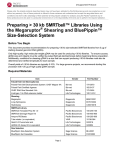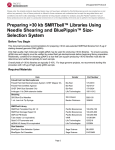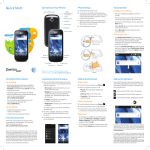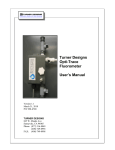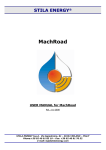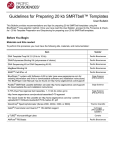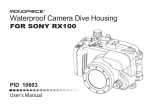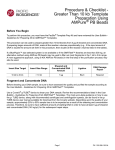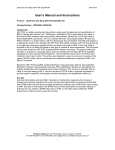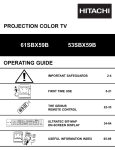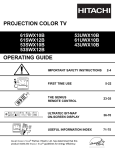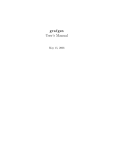Download File - Pacific Biosciences
Transcript
PacBio SampleNet – Shared Protocol Please note: the s hared protoc ols desc ribed herein m may not have been validated by Pac ific Biosc iences and are provided as-is and w without any warranty. Use of these protoc ols is offered to those customers who unders tand and ac cept the assoc iated term s and ® c onditions and wish to tak e advantage of their potential to help prepare samples for analys is us ing the PacBio System.If any of thes e protocols are to be used in a produc tion environment, it is the responsibility of the end user to perform the required validation. 20-kb Template Preparation Using BluePippin™ Size-Selection System (15-kb Size Cutoff) Before You Begin This procedure can be used to prepare size-selected libraries from 5 μg of sheared DNA using a 15-kb cutoff in the BluePippin Size-Selection system.With the “0.75%, DF Marker S1 high-pass 15 kb – 20 kb” protocol, size-selection cutoffs can be set to 15 kb up to 20 kb. This defines the lower edge of the range to be collected. Because size selection is aggressive, library yield using a 15-kb cutoff m ay be heavily im pacted depending on the distribution of the starting sheared DNA. Therefore, it is imperative to QC samples prior to shearing. Running DNA on Pulsed-Field Gel Electrophoresis (PFGE), Field-Inversion Gel Electrophoresis (FIGE), or any other electrophoretic system that provides good separation and accurate fragment sizing is highly recommended. High molecular weight DNA migrates as a band at approxi mately 48 kb (Bio-Rad 8-48 kb DNA size standard) when run on PFGE or FIGE. See Sample 1 in Figure 1 as an example of genomic DNA with high molecular weight. Although the sample appears to be slightly fragmented (smeared), the majority of the DNA is high molecular weight as shown by a strong band at approxim at ely48 kb. With this DNA quality, proceed to the shearing step outlined in the “Fragment and Concentrate” section. If the sample is severely fragmented as in the Sample 2, you m ay eliminate the shearing step and proceed to library construction directly. However, a 15-kb cutoff may not be appropriate for this sample since it could result in a loss of the majority of the sample. Consider using a less aggressive sizing cutoff (6 kb - 10 kb). 48 15.0 10.1 Figure 1: FIGE (Pippin Puls e) of 5-Mb genome. Exam ples of high m olecular w eight DNA (Sam ple 1) and fragm ented DNA (Sample 2). Page 1 PacBio SampleNet – Shared Protocol A good shearing strategy is also key to constructing a good 20-kb library using a 15-kb cutoff. Use the shearing procedure outlined in the “Fragment and Concentration” section. An example of sheared DNA using the recommended procedure is shown in Figure 2. Ideally, the m ode of fragm ent distribution should be on or larger than the 17-kb marker. Perform tests to determine the best shearing condition for your sample. Overshearing will result in very low yield. With 15 kb as the size cutoff, 10 µg sheared gDNA going into the repair steps will typically generate sufficient size-selected libraries for large-genome sequencing projects. This procedure is optimized for 5 µg of sheared gDNA. If working with 10 µg of sheared gDNA, scale all the reaction volumes proportionally (e.g., if the input amount of DNA is double the amount set forth in this procedure, double all the reaction volumes listed in the tables). Figure 2: Bioanalyzer trac e of a 20-k b E. c oli sheared DNA. Ideally, fragm ent distribution should m igrate on, or be larger than, the 17kb m arker (12000 ladder). If the m ode is smaller than 17 k b, a m ajority of the sam ple may be los t w hen us ing a 15-kb size s election cutoff. If using this protocol for the first time, we strongly recommend that you process a control sample first. Using the DNA shearing methods and subsequent AMPure PB bead purification steps described below, you should recover approximately 50%-80% of your input DNA (by m ass). Typical yields, from pre-purified DNA (where smaller fragments are already eliminated as a result of the shearing process) are between 80-100%. Insert Size Target 20 kb Insert Size Range Sheared and Concentrated DNA Amount Ligation 5 μg Blunt 15 kb to 20 kb (size-selected using BluePippin system) DNA Handling: When constructing large insert libraries, we highly recommend using gentle mixing instead of vortexing. Vigorous vortexing can potentially damage large fragments. Gentle mixing can be done on a rotator (same rotator used for MagBead binding) at room temperature for 20 minutes. Page 2 PacBio SampleNet – Shared Protocol BluePippin™ System Recommendations: Refer to the table of recommendations below for guidelines when using the BluePippin system. Yield, after the size-selection step, depends on shear distribution. Mass of SMRTbell Library < 2 µg >600 ng >5 µg Size Selection Cut-off Requirement 4,000 to 5,000 kb 6,000 kb to 10,000 kb 15,000 kb to 20,000 kb Recommended Cutoff (bp) BP start BP end* Cassette Definition File Version Mar -ker 4,000 50,000 0.75%DF Marker S1 high-pass 4-10kb v2 v2 S1 5,000 50,000 0.75%DF Marker S1 high-pass 4-10kb v2 v2 S1 6,000 50,000 0.75%DF Marker S1 High-Pass 6-10kb v3 v3 S1 7,000 50,000 0.75%DF Marker S1 High-Pass 6-10kb v3 v3 S1 8,000 50,000 0.75%DF Marker S1 High-Pass 6-10kb v3 v3 S1 9,000 50,000 0.75%DF Marker S1 High-Pass 6-10kb v3 v3 S1 10,000 50,000 0.75%DF Marker S1 High-Pass 6-10kb v3 v3 S1 15,000 50,000 0.75%DF Marker S1 high-pass 15-20kb 0 S1 16,000 50,000 0.75%DF Marker S1 high-pass 15-20kb 0 S1 17,000 50,000 0.75%DF Marker S1 high-pass 15-20kb 0 S1 18,000 50,000 0.75%DF Marker S1 high-pass 15-20kb 0 S1 19,000 50,000 0.75%DF Marker S1 high-pass 15-20kb 0 S1 20,000 50,000 0.75%DF Marker S1 high-pass 15-20kb 0 S1 *BP end should always be set to 50,000 Page 3 Kit Part Number PAC20KB or BLF7510 PAC20KB or BLF7510 PAC20KB or BLF7510 PAC20KB or BLF7510 PAC20KB or BLF7510 PAC20KB or BLF7510 PAC20KB or BLF7510 PAC20KB or BLF7510 PAC20KB or BLF7510 PAC20KB or BLF7510 PAC20KB or BLF7510 PAC20KB or BLF7510 PAC20KB or BLF7510 PacBio SampleNet – Shared Protocol Fragment and Concentrate DNA Gentle mixing is recommended for large-insert libraries (20 kb), 15-kb size selected. Typical yields after shearing and AMPure purification are 50-70%, depending on the quality and purity of the input gDNA. Use a Covaris® g-TUBE® device to shear > 10 μg DNA sample. The most up-to-date guidance on how to use the g-TUBE device, along with recommended centrifuges and centrifugation speeds, can be found in the g-TUBE device user manual available for download from the Covaris website or the Shared Protocols page of SampleNet, with the recommendations below. It is highly recommended to perform test shears first to ensure fragment distribution is on or above the 17-kb marker of the Bioanalyzer instrument. 1. Dilute your DNA concentration to 100-300 ng/μL in Elution Buffer (EB). PacBio recommends a sample volume of at least 100 μL. 2. Shear at 4800 rpm for 2 minutes in an Eppendorf® MiniSpin plus. 3. Check for residual volum e remaining in the upper chamber. If present, spin again at 4800 rpm for an additional two minutes. Repeat this spin cycle until most if not all of the sample has passed through the orifice. 4. If a small volume persists, perform a final spin at 8000 - 10000 rpm to push everything through the orifice. Do not do this step if a large volume of your sample is still present in the upper chamber. You m ay also use a pipette to remove the residual volume that does not make it through the orifice. 4. Invert and spin at 4800 until all samples have passed through the orifice. 5. Recover your sample into a 1.5 or 2.0 mL LoBind microcentrifuge tube. Add EB if necessary to adjust volume to 100 μL for the concentration step below. Page 4 PacBio SampleNet – Shared Protocol ST EP 1 Concentrate DNA Add 0.45X volume of AMPure® PB magnetic beads. μL of sample X 0.45X = μL of beads Note that the beads must be brought to room temperature and all AMPure PB bead purification steps should be performed at room temperature. Before using, mix the bead reagent well until the solution appears hom ogenous. Pipette the reagent slowly since the bead mixture is viscous and precise volumes are critical to the purification process. 2 Mi x bead/DNA solution thoroughly by tapping the tube gently. Do not pipet to mix. 3 Quickly spin down the tube (for 1 second) to collect the beads. 4 Allow the DNA to bind to beads by gentle end-over-end rotation for 20 minutes at room temperature. We recommend using a VW R tube rotator. 5 Spin down the tube (for 1 second) to collect beads. 6 Place the tube in a magnetic bead rack until the beads collect to the side of the tube and the solution appears clear. The actual time required t o collect the beads to the side depends on the volume of beads added. 7 With the tube still on the magnetic bead rack, slowly pipette off cleared supernatant and save in another tube. Avoid disturbing the bead pellet. If the DNA is not recovered at the end of this Procedure, you can add equal volumes of AMPure PB beads to the saved supernatant and repeat the AMPure PB bead purification steps to recover the DNA. 8 W ash beads with freshly prepared 70% ethanol. Note that 70% ethanol is hygroscopic and should be prepared FRESH to achieve optim al results. Also, 70% ethanol should be stored in a tightly capped polypropylene tube for no m ore than 3 days. – Do not remove the tube from the m agnetic rack. – Use a sufficient volume of 70% ethanol to fill the tube (1.5 mL for 1.5 m L tube or 2 m L for 2 m L tube). Slowly dispense the 70% ethanol against the side of the tube opposite the beads. Let the tube sit for 30 seconds. – Do not disturb the bead pell et. – After 30 seconds, pipette and discard the 70% ethanol. 9 10 Repeat step 8. Rem ove residual 70% ethanol. – Rem ove tube from m agnetic bead rack and spin to pellet beads. Both the beads and any residual 70% ethanol will be at the bottom of the tube. – Place the tube back on m agnetic bead rack. – Pipette off any rem aining 70% ethanol. 11 Check for any remaining droplets in the tube. If droplets are present, repeat step 10. Page 5 Notes PacBio SampleNet – Shared Protocol ST EP Concentrate DNA 12 Rem ove the tube from the m agnetic bead rack and allow beads to air-dry (with the tube caps open) for 30 to 60 seconds. 13 Calculate appropriate volum e of Elution Buffer. ng X 0.5 / ( ng/μL) = μL of Elution Buffer needed The m inimum DNA concentration required to proceed to the next step (End-Repair) is 140 ng/μL with preferred m ass of at least 5 μg. 14 Add the Pacific Biosciences® Elution Buffer volum e (calculated in step 13) to your beads. Close the tube and tap with finger to mix. Do not pipet to mix. – Elute the DNA by gentle rotation/mixing for 20 minutes at room temperature. – Spin the tube down to pellet beads, then place the tube back on the m agnetic bead rack. – Perform concentration m easurem ents. Verify your DNA concentration using a Nanodrop® or Qubit® quantitation platform . If the DNA concentration is estim ated to be equal to or below 12 ng/μL, a Qubit system reading is required. W hen perform ing a Qubit system reading, ensure that your sam ple is within the range of the Qubit kit you are using. For proper concentration calculations, incorporate the dilution factor (used when diluting your sam ple) to be within range of the Qubit kit and the dilution factor when diluting your sam ple with the working solution. The latter part of this dilution factor can be calculated autom atically by the Qubit system. – Discard the beads. 15 Perform qualitative and quantitative analysis using a Bioanalyzer® instrum ent. Note that the Bioanalyzer instrument has different kits in its offering and the appropriate kit, based on insert size, should be used. Dilute the sam ples appropriately before loading on the Bioanalyzer chip so that the DNA concentration loaded falls well within the detectable m inimum and maxim um range of the assay. Refer to Agilent Technologies’ guides for specific information on the range of the specific kit you m ight be using. Note that typical yield, at this point of the process (i.e. post-shearing and after one 0.45X AMPure PB bead purification), is approxim ately 50%-80%. 16 The sheared DNA can be stored for up to 24 hours at 4°C or at -20°C for longer duration. 17 Actual recovery per μL and total availabl e sam ple m aterial: Page 6 Notes PacBio SampleNet – Shared Protocol ExoVII Treatment of DNA Use the foll owing table to rem ove single-stranded ends from DNA fragm ents. If preparing larger am ounts of DNA, scale the reaction volum es accordingly (i.e., for 10 μg of DNA scale the total volum e to 100 μL). Do not exc eed 100 ng/μL of DNA in the final reaction. 1. In a LoBind microcentrifuge tube, add the following reagents: Reagent Sheared DNA Tube Cap Color Stock Conc. Volume μL for 5.0 μg − Final Conc. − DNA Dam age Repair Buffer 10 X 5.0 μL 1X NAD+ 100 X 0.5 μL 1X ATP high 10 mM 5.0 μL 1 mM dNTP 10 mM 0.5 μL 0.1 mM ExoVII 10 U/μL 1.0 μL 0.2 U/μL H2O μL to adjust to 50.0 μL − 50.0 μL Total Volume 2. Mix the reaction well by gently tapping the tube. 3. Spin down contents of tube with a quick spin in a m icrofuge. 4. Incubate at 37°C for 15 minutes, then return the reaction to 4°C. Page 7 − − Notes PacBio SampleNet – Shared Protocol Repair DNA Damage Use the foll owing table to prepare your reaction. Reagent DNA (ExoVII treat ed) Tube Cap Color Stock Conc. − 25 X DNA Dam age Repair Mi x Total Volum e Volume Final Conc. 50 μL − 2.0 μL 1X 52.0 μL − Notes 1. Mix the reaction well by gently tapping the tube. 2. Spin down contents of tube with a quick spin in a m icrofuge. 3. Incubate at 37°C for 20 minutes, return the reaction to 4°C for 1 to 5 minutes. Repair Ends Use the foll owing table to prepare your reaction, then purify the DNA. Reagent DNA (Dam age Repaired) End Repair Mi x Tube Cap Color Stock Conc. − 20 X Total Volum e Volume Final Conc. 52.0 μL − 2.5 μL 1X 54.5 μL − 1. Mix the reaction well by gently tapping the tube. 2. Spin down contents of tube with a quick spin in a m icrofuge. 3. Incubate at 25°C for 5 m inutes, return the reaction to 4°C. Page 8 Notes PacBio SampleNet – Shared Protocol ST EP Purify DNA 1 Add 0.45X volum e of AMPure PB beads to the End-Repair reaction. (For detailed instructions on AMPure PB bead purification, see the Concentrate DNA section.) 2 Mi x the bead/DNA solution thoroughly by gently tapping the tube. 3 Quickly spin down the tube (for 1 second) to collect the beads. Do not pellet beads. 4 Allow the DNA to bind to beads by gentle rotation for 20 minutes at room temperature. W e recomm end using a VW R tube rotator. 5 Spin down the tube (for 1 second) to collect beads. 6 Place the tube in a m agnetic bead rack to collect the beads to the side of the tube. 7 Slowly pipette off cleared supernatant and save (in another tube). Avoid disturbing the bead pell et. 8 W ash beads with freshly prepared 70% ethanol. 9 Repeat step 8. 10 Rem ove residual 70% ethanol. – Rem ove tube from m agnetic bead rack and spin to pellet beads. Both the beads and any residual 70% ethanol will be at the bottom of the tube. – Place the tube back on m agnetic bead rack. – Pipette off any rem aining 70% ethanol. 11 Check for any rem aining droplets in the tube. If droplets are present, repeat step 10. 12 Rem ove the tube from the m agnetic bead rack and allow beads to air-dry (with tube caps open) for 30 to 60 seconds. 13 Elute the DNA off the beads in 20 μL Elution Buffer. Mix by gently tapping the tube, elute by rotating the tube for 20 minutes at room temperature. 14 Optional: Verify your DNA amount and concentration using a Nanodrop or Qubit quantitation platform, as appropriate. 15 Optional: Perform qualitative and quantitative analysis using a Bioanalyzer instrum ent with the DNA 12000 Kit. Note that typical yield at this point of the process (foll owing End-Repair and one 0.45X AMPure PB bead purification) is approxim ately between 80-100% of the total starting m ateri al. 16 The End-Repaired DNA can be stored overnight at 4°C or at -20°C for longer durations. 17 Actual recovery per μL and total availabl e sam ple m aterial: Page 9 Notes PacBio SampleNet – Shared Protocol Prepare Blunt-Ligation Reaction Use the foll owing table to prepare your blunt-ligation reaction: 1. In a LoBind microcentrifuge tube (on ice), add the following reagents in the order shown. If preparing a Master Mi x, ensure that the adapter is NOT mixed with the ligase prior to introduction of the inserts. Reagent Tube Cap Color Stock Volume Final Conc. Notes Conc. DNA (End Repaired) − 19.0 μL to 20.0 μL 20 μM Annealed Blunt Adapter (20 μM) 10* μL 5 μM Mix before proceeding Tem plate Prep Buffer 10 X 4.0 μL 1X ATP low 1 mM 2.0 μL 0.05 mM Mix before proceeding Ligase 1.0 μL 30 U/μL H2O − − Total Volum e − − μL to adjust to 40.0 μL 40.0 μL 0.75 U/μL − − *Note that this increase in adapter during ligation mi ni mi zes the incidence of chi me ras. Adapter di mers are the n efficiently removed during si ze s election in the Bl uePippi n System. T his is not reco mmended for libraries which are not being si ze selected using the BluePippin Syste m. 2. 3. 4. 5. Mix the reaction well by gently tapping the tube. Spin down contents of tube with a quick spin in a m icrofuge. Incubate at 25°C overnight. Incubate at 65°C for 10 minutes to inactivate the ligase, then return the reaction to 4°C. You m ust proceed with adding exonuclease after this step. Add exonuclease to rem ove fail ed ligation products. Reagent Tube Cap Color Stock Conc. Volume 40 μL Ligated DNA Mix reaction well by pipetting ExoIII 100.0 U/μL 1.0 μL ExoVII 10.0 U/μL 1.0 μL 42 μL Tot al Volume 1. Spin down contents of tube with a quick spin in a m icrofuge. 2. Incubate at 37°C for 1 hour, then return the reaction to 4°C. You must proceed with purification after this step. Page 10 PacBio SampleNet – Shared Protocol Purify SMRTbell™ Templates ST EP Purify SM RTbell Templates 1 Add 0.45X volum e of AMPure PB beads to the exonuclease-treated reaction. (For detail ed instructions on AMPure PB bead purification, see the Concentrat e DNA section). 2 Mi x the bead/DNA solution by gently tapping the tube. 3 Quickly spin down the tube (for 1 second) to collect the beads. Do not pellet beads. 4 Allow the DNA to bind to beads by gentle rotation for 20 minutes at room temperature. W e recomm end using a VW R tube rotator. 5 Spin down the tube (for 1 second) to collect beads. 6 Place the tube in a m agnetic bead rack to collect the beads to the side of the tube. 7 Slowly pipette off cleared supernat ant and save (in another tube). Avoid disturbing the bead pellet. 8 W ash beads with freshly prepared 70% ethanol. 9 Repeat step 8. 10 Rem ove residual 70% ethanol. – Rem ove tube from m agnetic bead rack and spin to pellet beads. Both the beads and any residual 70% ethanol will be at the bottom of the tube. – Place the tube back on m agnetic bead rack. – Pipette off any rem aining 70% ethanol. 11 Check for any rem aining droplets in the tube. If droplets are present, repeat step 10. 12 Rem ove the tube from the m agnetic bead rack and allow beads to air-dry (with tube caps open) for 30 to 60 seconds. 13 Elute the DNA off the beads in 31 μL of Elution Buffer. Mix by gently tapping the tube, elute by rotating the tube for 20 minutes at room temperature Page 11 Notes PacBio SampleNet – Shared Protocol BluePippin™ Size Selection Follow the recomm endations below and the BluePippin User Manual and Quick Guide (to www.sagescience.com ) to size-select your ~20-kb SMRTbell tem plates using the BluePippin instructions. Be sure you have revi ewed the recomm endations listed in the User Bulletin - Guidelines for Preparing 20 kb SMRTbell™ Templates. Note that you must use the BluePippin “0.75%, DF Marker S1 high-pass 15 kb – 20 kb” protocol for this procedure. It is highly recommended to upgrade the BluePippin Software to v6.20 to enable simultaneous sample elution and the auto-lights off feature. If you have upgraded to v6.20, skip this section and proceed to "Prepare DNA Samples for Each Lane". See the table below for features of each software version. Software Version < 6.11 6.11 6.20 Elution Blue LED Lights One sample at a time Simultaneous elution Simultaneous elution Turn off manually Turn off manually Auto lights off If you have not upgraded to v6.20 and are running v6.11 or lower, follow the instructions below on how to "Calibrate and Turn Off LEDs". During the elution step, sam ples m ay be exposed to blue LEDs as they are queued for elution. This exposure m ay result in dam age to the SMRTbell tem plates. W e recomm end turning off the blue LEDs for all lanes exc ept the S1 Marker lane. If you are running v6.11 or lower, it is recomm ended to run the BluePippin system overnight when running several sam ples. Separation tim e is approxim ately 3 hours and elution tim e is approxim ately 45 m inutes. ST EP Calibrate and Turn Off LEDS 1 Place the calibration fixture on the nest of the instrument and close the lid. Click “Calibrate” from the main screen. Click “Calibrate” in the calibration pop up window. 2 After calibration passes, click “Exit”. 3 From the main screen, click on the BluePippin logo located in the lower right corner. 4 Enter the password “pips” to display advanced user tabs. 5 Select the “LED Setup Tab”. 6 Adjust the LED Counts to zero in the lanes that you want to turn off the LED. Double click on the LED count to highlight the number and enter “0”. Notes IMPORTANT: Do not change the LED count in the lane that will contain the S1 reference marker. 7 Click on “Apply (Enter)” to save calibration values. 8 Verify that the LEDs are turned off. 9 The instrument is now ready for use. Note that instrument calibration (step 1) will turn on all LEDs. For other applications that do not require LEDs to be turned off, set the instrument to hide the “advanced tabs”: 1. Click on the BluePippin logo in the lower right corner of the main screen. 2. Do not enter a password in the pop up window. 3. Click “OK”. Page 12 PacBio SampleNet – Shared Protocol ST EP 1 2 3 4 Prepare DNA Samples for Each Lane If necessary, dilute up to 5 μg SMRTbell tem plates into a final volum e of 30 μL Elution Buffer. Run 500 ng to 5 μg SMRTbell tem plates per lane. It’s not recomm ended to start with less than 500 ng per lane. Bring the Loading Solution to room tem perature, then add 10 μL of the Loading Solution to the 30 μL DNA sample. The Loading Solution is viscous so pipet slowly to ensure it is com pletely transferred into the DNA sam ple. Mix by gentle mixing; do not vortex. Spin briefly to collect the contents at the bottom . Follow the m anufacturer’s recomm endations to set up a run protocol. W hen setting up the run protocol, select the “0.75% DF m arker S1 high-pass 15-20kb” cassette definition file. Choose the “Range” selection m ode, and enter the desired “BPstart” value from 15000-20000 bp. Enter a “BP End” value of 50000 bp. Start the run. Collect eluate into a 1.5 or 2.0 m L LoBind microcentrifuge tube. Note that volum es m ay vary from approxim ately 40 to 60 μL. Proceed directly to AMPure purification at this point. 5 Note: It is highly recomm ended to wait at least 45 minutes aft er the run term inates before rem oving the eluted DNA. This has shown an increase in recovery of SMRTbell libraries. Page 13 Notes PacBio SampleNet – Shared Protocol Concentrate size-selected SMRTbell tem plates in a 1.5 or 2.0 mL LoBind microcentrifuge tube using 1X AMPure PB beads. ST EP Concentrate and Quantify Size-Selected Templates 1 Measure volum e of eluate and overlay sam ple with an equal volum e of AMPure PB beads. 2 Mi x the bead/DNA solution thoroughly by gently tapping the tube. 3 Quickly spin down the tube (for 1 second) to collect the beads. 4 Allow the DNA to bind to beads by gentle rotation for 20 minutes at room temperature. W e recomm end using a VWR tube rotator. 5 Spin down the tube (for 1 second) to collect beads. 6 Place the tube in a m agnetic bead rack to collect the beads to the side of the tube. 7 Slowly pipette off cleared supernat ant and save (in another tube). Avoid disturbing the bead pellet. 8 W ash beads with freshly prepared 70% ethanol. 9 Repeat step 8. 10 Rem ove residual 70% ethanol. – Rem ove tube from m agnetic bead rack and spin quickly. – Place the tube back on m agnetic bead rack. – Pipette off any rem aining 70% ethanol. 11 Check for any rem aining droplets in the tube. If droplets are present, repeat step 10. 12 Rem ove the tube from the m agnetic bead rack and allow beads to air-dry (with tube caps open) for 30 to 60 seconds. 13 Elute DNA from beads by adding 10 μL EB onto beads. Mix gently by tapping the tube. Elute the DNA by gentle mixing using a rotator for 20 minutes. NOTE: For up to 5 μg input DNA, elute in 10 μL. For > 5 μg input DNA (if multiple lanes were pooled for this step), scale the elution volum e proportionat ely. 14 Spin briefly t o collect the contents at the bottom of the tube. 15 Return sam ple to m agnetic rack and let stand until beads are well-separat ed. Collect to the side of the tube. 16 Transfer supernatant containing size-selected SMRTbell templates to a new LoBind m icrocentrifuge tube. Page 14 Notes PacBio SampleNet – Shared Protocol ST EP Concentrate and Quantify Size-Selected Templates 17 Use 1 μL of purified SMRTbell tem plates to m ake a 1:5 dilution in EB, and m easure the DNA concentration using a Qubit fluorom eter. Retain the rem aining 4 μL of diluted sam ple for QC by FIGE. Notes NOTE: Typical yields of size-selected, ~20 kb SMRTbell library from 500 ng - 5 μg input m aterial are 20-40%. Anneal and Bind BluePippin™ Size-Selected SMRTbell™ Templates Use the Binding Calculator to anneal sequencing prim er at 0.833 nM concentration and bind polym erase at 0.500 nM concentration. These are the default concentrations required for 20 kb libraries. Note that you m ust have the PacBio DNA/Polym erase Kit and use LoBind m icrocentrifuge tubes for this step. Before adding the primer to the SMRTbell template, the primer must be heated to 80ºC followed by a rapid cooldown to 4ºC. The conditioned primer can then be added to the SMRTbell template in 1X Primer Buffer, followed by incubation at 20 ºC for 30 minutes. For polymerase binding, incubation at 30ºC for 30 minutes is sufficient. Instructions for polymerase binding are provided by the calculator. For more information about using the Binding Calculator, see the Pacific Biosciences Template Preparation and Sequencing Guide and QRC - Annealing and Binding Recommendations. Prepare for MagBead Loading Optimal loading of size-selected ~20 kb tem plates using P6 polym erase can be achieved using an onplate concentration of ~0.100 nM. An initial loading test on-plate concentration of 0.100 nM is highly recommended. For efficient binding to Magnetic Beads, bound com plexes (at 0.500 nM concentration) m ust be diluted in the appropriate ratio of MagBead Binding Buffer and MagB ead W ash Buffer. Follow the Binding Calculator instructions to dilute your sam ple for MagBead binding. Control Complex Dilution If you will be using the PacBio Control Com plex, dilute the DNA Control Complex according to the volum es and instructions specified in the Calculator. Sequence To prepare for sequencing on the instrum ent, refer to the RS Remote Online Help system or Pacific Biosciences Software Getting Started Guide for m ore inform ation. Follow the touchscreen UI to start your run. Note that you must have a DNA Sequencing Kit and SMRT® Cells for standard sequencing. W hen sequencing size-sel ected ~20 kb SMRTbell tem plates prepared by this m ethod, be sure to indicate the m agnetic bead collection protocol, a 20,000 bp insert size, stage start, and 240 m inute m ovies when setting up your run protocol in RS Rem ote. For Research Use O nly. Not for use in diagnostic procedures. © Copyright 2015, Pacific Biosciences of California, Inc. All rights reserved. I nformation in this document is subject to change without notice. Pacific Biosciences assumes no responsibility for any errors or omissions in this document. Certain notices, terms, conditions and/o r use restrictions m ay pertain to your use of Pacific Biosciences products and/or third p arty products. Please refer to the applicable Pacific Biosciences Terms and Conditions of S ale and to the applicable license terms at http://www.pacificbiosciences.com/lice nses.html. Pacific Biosciences, the Pacific Biosciences logo, PacBio, S MRT, SMRTbell and Iso-Seq are trademarks of Pacific Biosciences. BluePippin and SageELF are tradem arks of Sage Science, Inc. NGS-go and NGSengine are tradem arks of GenDx. All other tradem arks are the sole property of their respective owners. Page 15















